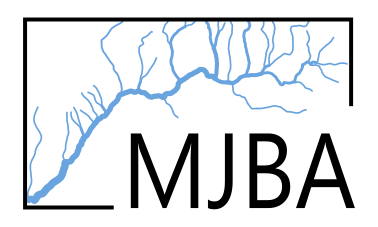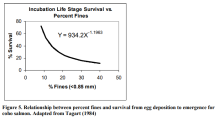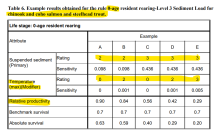Tagart 1984: Fines and Coho Egg to Fry Surv.
mbayly
View all records in the stressor response library
Species Common Name
Coho Salmon
Latin Name (Genus species)
Oncorhynchus kisutch
Stressor Name
Fines
Specific Stressor Metric
Substrate Fine Coverage (<0.85mm)
Stressor Units
Rank Score
Vital Rate (Process)
Survivorship
Geography
Clearwater River, western Washington
Key Covariates and Dependencies
Temperature
Detailed SR Function Description
Excerpt from Lestelle et al., 2024:
"We employed the empirical relationship reported by Tagart (1984) for the effects of percent
fine sediment (<0.85 mm) on survival to emergence for coho (Figure 5). We assumed the
same relationship is applicable to chinook salmon and steelhead trout. Using a benchmark
survival to emergence of 60% (assumed average survival under optimal conditions for
chinook and coho), we can convert Tagart's survivals into sensitivity (as 1 minus survival
divided by the benchmark) and plot the values against the appropriate Level 2 rating values
on the x-axis (Figure 6). The resulting relationship forms the rule for sediment effects on the
incubation life stage, except when the hydrologic regime is mainly characterized as
groundwater fed.7 In that case, upwelling associated with groundwater sources appears to
largely protect embryos from deleterious effects of high fines (Bjornn and Reiser 1991,
Waters 1995). This explains why salmonids can have high rates of reproduction in some
streams despite excessive deposits of fine sediment (e.g., chum and sockeye salmon are
known to spawn heavily in groundwater fed streams, even in areas of excessive fines). We
therefore created a Rule Category for this hydrologic regime that maintained high survivals
even at high levels of fine sediment"
Consider important interaction with temperature
Function: Y = 934.2X-1.1963
Keywords: Fine, fines, sediment, sedimentation, erosion. substrate.
"We employed the empirical relationship reported by Tagart (1984) for the effects of percent
fine sediment (<0.85 mm) on survival to emergence for coho (Figure 5). We assumed the
same relationship is applicable to chinook salmon and steelhead trout. Using a benchmark
survival to emergence of 60% (assumed average survival under optimal conditions for
chinook and coho), we can convert Tagart's survivals into sensitivity (as 1 minus survival
divided by the benchmark) and plot the values against the appropriate Level 2 rating values
on the x-axis (Figure 6). The resulting relationship forms the rule for sediment effects on the
incubation life stage, except when the hydrologic regime is mainly characterized as
groundwater fed.7 In that case, upwelling associated with groundwater sources appears to
largely protect embryos from deleterious effects of high fines (Bjornn and Reiser 1991,
Waters 1995). This explains why salmonids can have high rates of reproduction in some
streams despite excessive deposits of fine sediment (e.g., chum and sockeye salmon are
known to spawn heavily in groundwater fed streams, even in areas of excessive fines). We
therefore created a Rule Category for this hydrologic regime that maintained high survivals
even at high levels of fine sediment"
Consider important interaction with temperature
Function: Y = 934.2X-1.1963
Keywords: Fine, fines, sediment, sedimentation, erosion. substrate.
Stressor Magnitude Data
Field measurements
Function Type
continuous
Stressor Scale
linear
References Cited
Lestelle, L. C., Mobrand, L. E., & McConnaha, W. E. (2004). Information structure of Ecosystem Diagnosis and Treatment (EDT) and habitat rating rules for Chinook salmon, Coho salmon, and Steelhead trout. Mobrand Biometrics, Inc. Copyright © 2004 Mobrand Biometrics, Inc. https://www.webpages.uidaho.edu/fish510/PDF/coho%20ck%20rules.pdf
Tagart, J. V. 1984. Coho salmon survival from egg deposition to fry emergence. in J. M. Walton and D.
B. Jouston, editors. Proceedings of the Olympic wild fish conference. Peninsula College Fisheries
Technology Program Port Angeles, WA.
Tagart, J. V. 1984. Coho salmon survival from egg deposition to fry emergence. in J. M. Walton and D.
B. Jouston, editors. Proceedings of the Olympic wild fish conference. Peninsula College Fisheries
Technology Program Port Angeles, WA.
Citation Link
Stressor Response csv data
egg_surv.csv
(274 bytes)
| Raw Stressor Values | Scaled Response Values 0 to 100 | SD | low.limit | up.limit |
|---|---|---|---|---|
| 6.5 | 99.5 | 0 | 0 | 100 |
| 8 | 77.6 | 0 | 0 | 100 |
| 10 | 59.4 | 0 | 0 | 100 |
| 15 | 36.6 | 0 | 0 | 100 |
| 20 | 25.9 | 0 | 0 | 100 |
| 25 | 19.9 | 0 | 0 | 100 |
| 30 | 16 | 0 | 0 | 100 |
| 35 | 13.3 | 0 | 0 | 100 |
| 40 | 11.3 | 0 | 0 | 100 |
| 45 | 9.8 | 0 | 0 | 100 |
| 50 | 8.7 | 0 | 0 | 100 |
| 55 | 7.7 | 0 | 0 | 100 |
Stressor Response Chart


